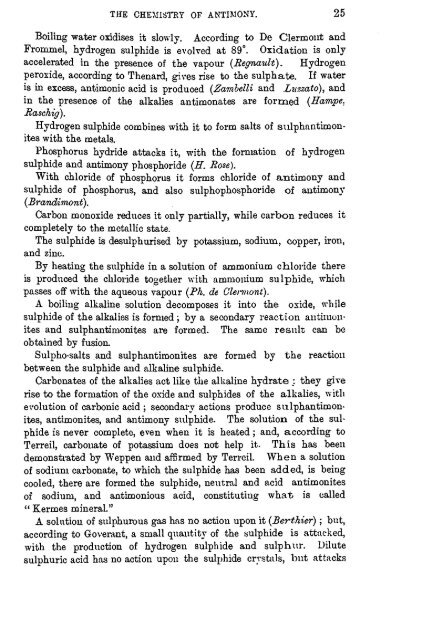antimony - Sciencemadness.org
antimony - Sciencemadness.org
antimony - Sciencemadness.org
Create successful ePaper yourself
Turn your PDF publications into a flip-book with our unique Google optimized e-Paper software.
THE CHEMISTRY OF ANTIMONY. 25<br />
Boiling water oxidises it slowly. According to De Clermont and<br />
Frommel, hydrogen sulphide is evolved at 89°. Oxidation is only<br />
accelerated in the presence of the vapour (Regnault). Hydrogen<br />
peroxide, according to Thenard, gives rise to the sulphate. If water<br />
is in excess, antimonic acid is produced (Zambelli and Zuzzato), and<br />
in the presence of the alkalies antimonates are formed (Hampe.<br />
Raschig).<br />
Hydrogen sulphide combines with it to form salts of sulphantimonites<br />
with the metals.<br />
Phosphorus hydride attacks it, with the formation of hydrogen<br />
sulphide and <strong>antimony</strong> phosphoride (E. Rose).<br />
With chloride of phosphorus it forms chloride of <strong>antimony</strong> and<br />
sulphide of phosphorus, and also sulphophosphoride of <strong>antimony</strong><br />
(Brandimont).<br />
Carbon monoxide reduces it only partially, while carbon reduces it<br />
completely to the metallic state.<br />
The sulphide is desulphurised by potassium, sodium, copper, iron,<br />
and zinc.<br />
By heating the sulphide in a solution of ammonium chloride there<br />
is produced the chloride together with ammonium sulphide, which<br />
passes off with the aqueous vapour (Ph. de Glerrnont).<br />
A boiling alkaline solution decomposes it into the oxide, while<br />
sulphide of the alkalies is formed ; by a secondary reaction autimonites<br />
and sulphanthnonites are formed. The same result can be<br />
obtained by fusion.<br />
Sulpho-salts and sulphantimonites are formed by the reaction<br />
between the sulphide and alkaline sulphide.<br />
Carbonates of the alkalies act like the alkaline hydrate : they give<br />
rise to the formation of the oxide and sulphides of the alkalies, with<br />
evolution of carbonic acid; secondary actions produce sulphantimonites,<br />
antimonites, and <strong>antimony</strong> sulphide. The solution of the sulphide<br />
is never complete, even when it is heated; and, according to<br />
Terreil, carbonate of potassium does not help it. This has been<br />
demonstrated by Weppen and affirmed by Terreil. When a solution<br />
of sodium carbonate, to which the sulphide has been added, is being<br />
cooled, there are formed the sulphide, neutral and acid antimonites<br />
of sodium, and antimonious acid, constituting what is called<br />
" Kermes mineral."<br />
A solution of sulphurous gas has no action upon it (Berthier); but,<br />
according to Goverant, a small quantity of the sulphide is attacked,<br />
with the production of hydrogen sulphide and sulphur. Dilute<br />
sulphuric acid has no action upon the sulphide crystals, but attacks
















